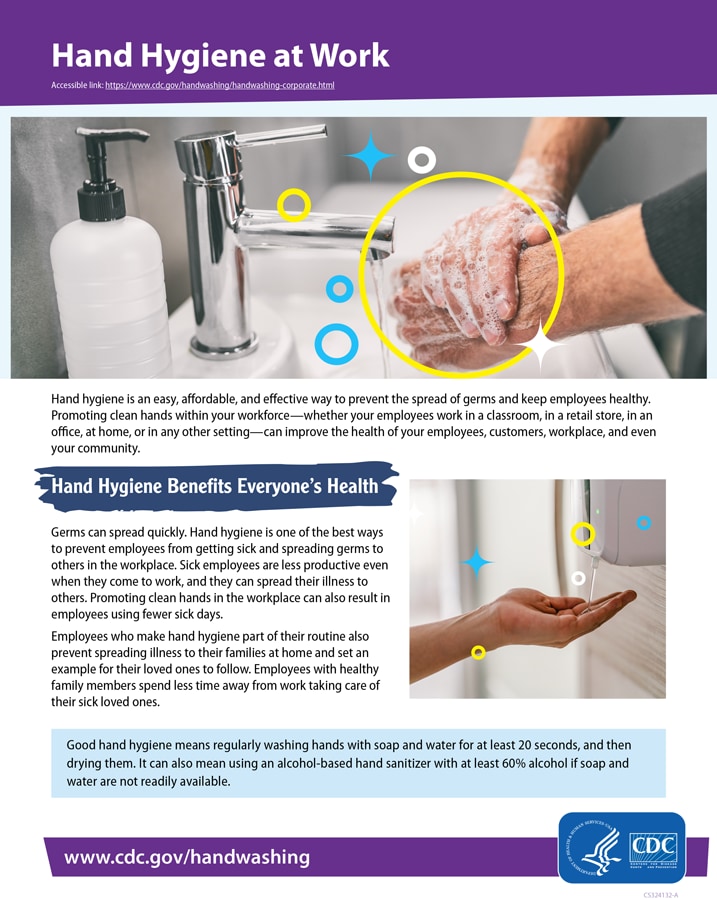Hand Hygiene at Work

Hand hygiene is an easy, affordable, and effective way to prevent the spread of germs and keep employees healthy. Promoting clean hands within your workforce—whether your employees work in a classroom, in a retail store, in an office, at home, or any other setting—can improve the health of your employees, customers, workplace, and even your community.
Hand Hygiene Benefits Everyone’s Health

Germs can spread quickly. Hand hygiene is one of the best ways to prevent employees from getting sick and spreading germs to others in the workplace. Sick employees are less productive even when they come to work, and they can spread their illness to others. Promoting clean hands in the workplace can also result in employees using fewer sick days.
Employees who make hand hygiene part of their routine also prevent spreading illness to their families at home and set an example for their loved ones to follow. Employees with healthy family members spend less time away from work taking care of their sick loved ones.
Good hand hygiene means regularly washing hands with soap and water for at least 20 seconds, and then drying them. It can also mean using an alcohol-based hand sanitizer with at least 60% alcohol if soap and water are not readily available.
Handwashing benefits the entire community by:
- Reducing respiratory illnesses, like colds, by 21%
- Reducing the number of people who get sick with diarrhea by 31%
- Reducing diarrheal illness in people with weakened immune systems by 58%
Key Times for Hand Hygiene
Tell employees that if their hands are visibly dirty, they should use soap and water instead of hand sanitizer. Key times for employees to clean their hands include:
- Before and after work
- Before and after breaks
- After blowing their nose, coughing, or sneezing
- After using the restroom
- Before eating or preparing food
Learn about the key times to wash hands during the COVID-19 pandemic: How to Protect Yourself & Others | CDC
Tips for Protecting Employee Health

Hand hygiene can lower the chances of spreading illnesses to others when you shake hands or touch common surfaces and objects, such as tables and doorknobs.
- Increase access to sinks that is accessible to all employees and in places such as bathrooms, food preparation areas, or in eating areas.
- Provide soap, water, and a way to dry hands (e.g. paper towels, hand dryer) so employees can wash and dry hands properly.
- Place hand sanitizer dispensers with at least 60% alcohol near frequently touched surfaces, in areas where soap and water are not easily accessible, such as near elevators, shared equipment, building entrances and exits, etc.
- Put visual reminders, like signs or posters, in bathrooms or kitchen areas to remind employees to wash their hands.
- Provide other hygiene supplies such as tissues and no-touch/foot pedal trash cans.
- Promote and model other healthy habits, such as covering coughs and sneezes, then washing hands.
- Clean frequently touched surfaces, such as countertops, handrails, and doorknobs regularly.
- Tell sick employees to stay home until they are symptom-free.
- Remind employees to practice and model good hand hygiene at home.
- Curtis V, Schmidt W, Luby S, Florez R, Touré O, Biran A. Hygiene: new hopes, new horizons.external icon Lancet Infect Dis. 2011;11(4):312-21.
- Jamieson D, Breman J, Measham A, Alleyne G, Claeson M, Evans D, Jha P, Mills A, Musgrove P. Disease control priorities in developing countries.external icon 2006. Oxford University Press: Oxford.
- Hubner N, Hubner C, Wodny M, Kampf G, Kramer A. Effectiveness of alcohol-based hand disinfectants in a public administration: impact on health and work performance related to acute respiratory symptoms and diarrhoea.external icon BMC Infect Dis. 2010;10:250.
- Ejemot RI, Ehiri JE, Meremikwu MM, Critchley JA. Hand washing for preventing diarrhoea.external icon Cochrane Database Syst Rev. 2008;1:CD004265.
- Huang DB, Zhou J. Effect of intensive handwashing in the prevention of diarrhoeal illness among patients with AIDS: a randomized controlled study.external icon J Med Microbiol. 2007;56(5):659-63.
- Aiello AE, Coulborn RM, Perez V, Larson EL. Effect of hand hygiene on infectious disease risk in the community setting: a meta-analysis.external icon Am J Public Health. 2008;98(8):1372-81.
- Judah G, Aunger R, Schmidt WP, Michie S, Granger S, Curtis V. Experimental pretesting of hand-washing interventions in a natural setting.external icon Am J Public Health. 2009;99 (2):S405-11.
